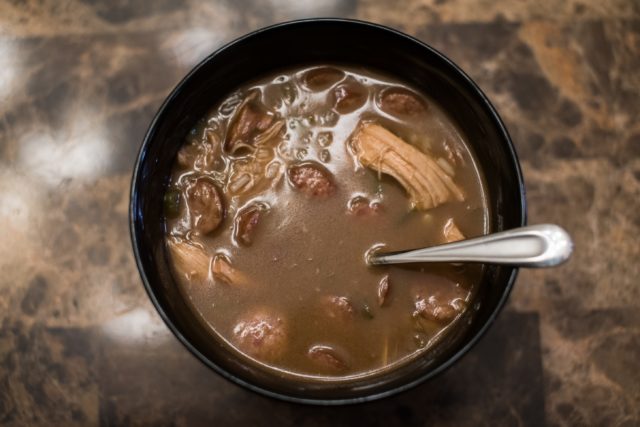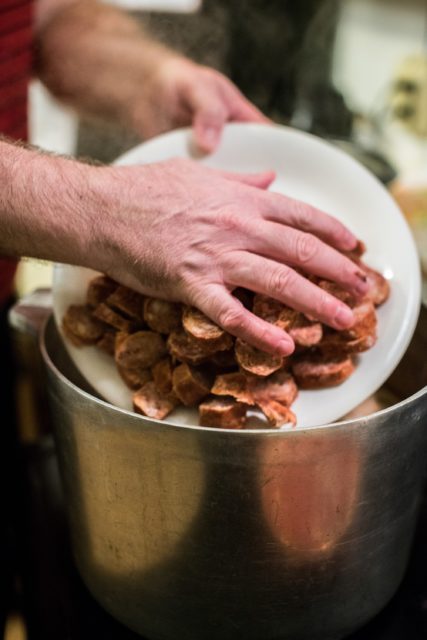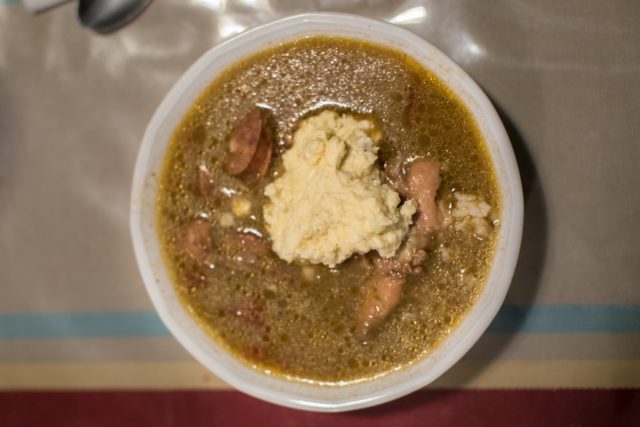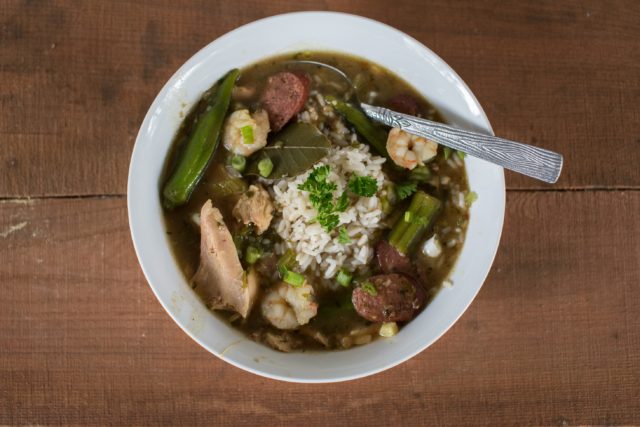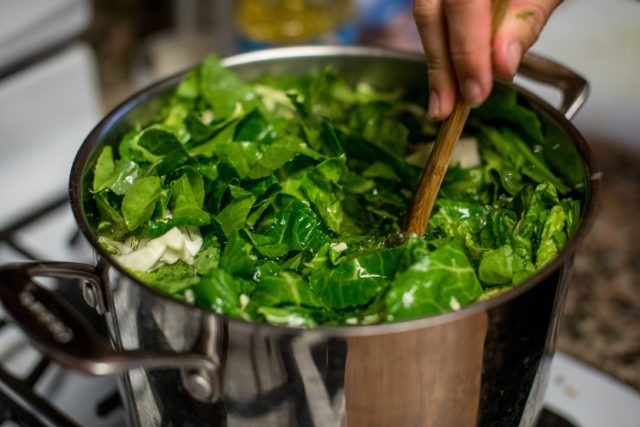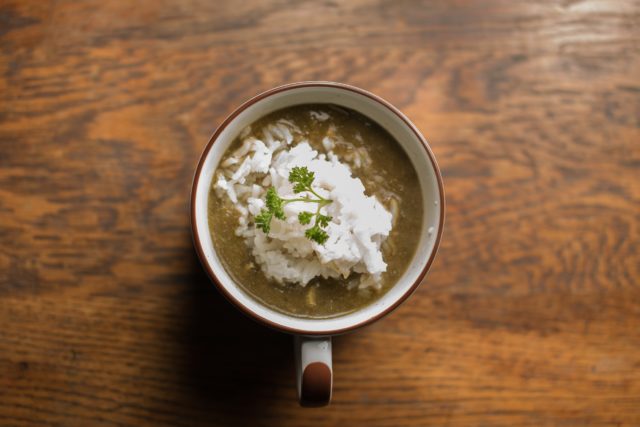Notes from a Gumbo Road Trip
A traveling writer stirs the pot
Published: August 30, 2019
Last Updated: March 22, 2023
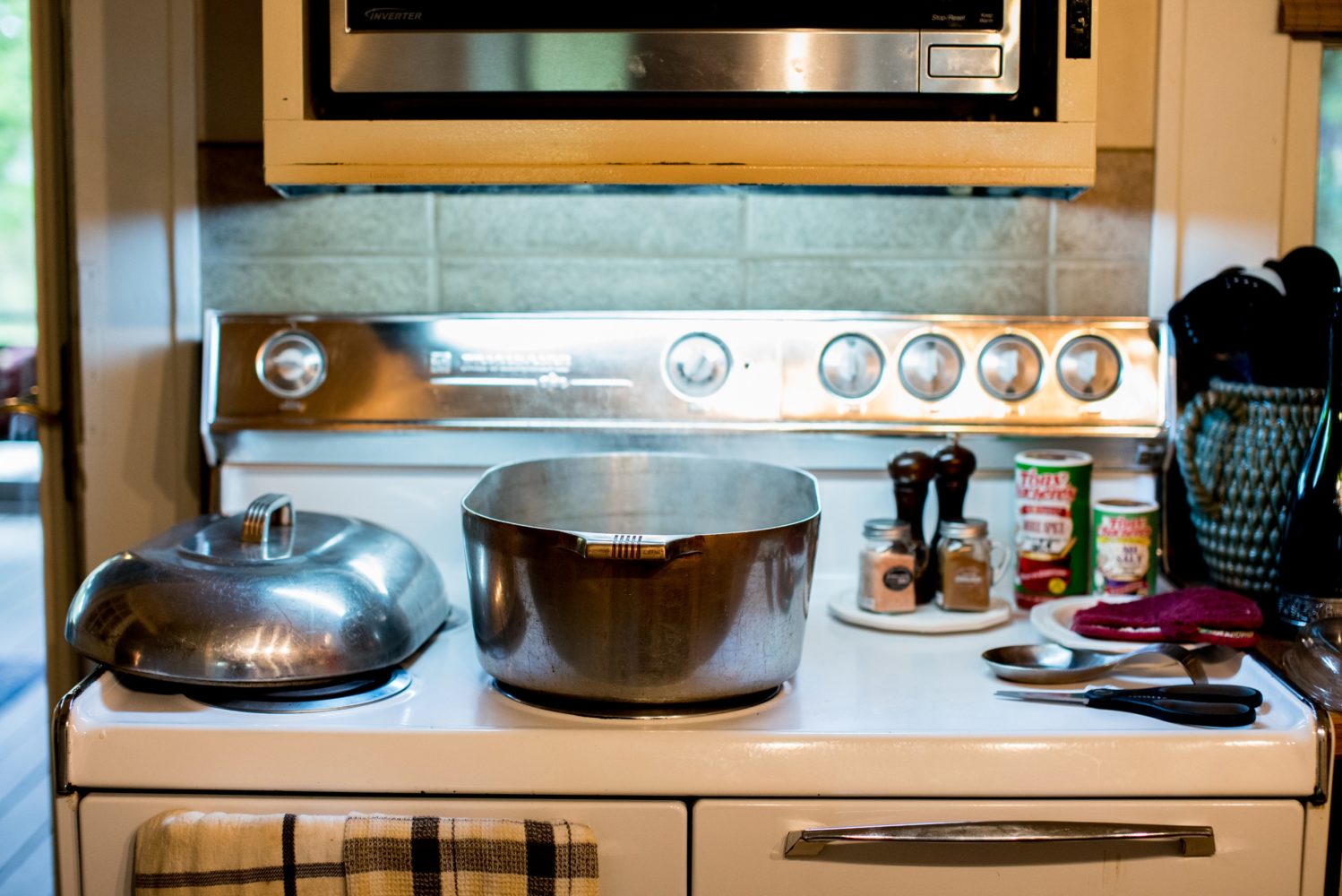
All photos by Christie Matherne Hall
A Magnalite pot and shakers of Tony Chachere’s seasoning await Madeline Rabalais Daly in her Opelousas kitchen.
The word gumbo either comes from kingombo, an Angolan word for okra, or kombo, the native Choctaw word for filé powder, but neither has much truth to tell regarding modern-day gumbo. Some Louisiana gumbos don’t use okra or filé at all. Some are thick like a gravy, some are thin and juicy. Some are tomatoey. Some are full of fresh crabs and oysters, while some have both chicken and seafood—though for every surf-and-turf gumbo, there’s a room full of Cajuns who won’t go anywhere near it.
Many restaurants in Louisiana serve gumbo, but the real beauty of it happens at home on holidays and dinner tables, on patios, or around bonfires; in fine china bowls or in “fine Chinet” as my dad calls it, with potato salad on the side or straight in the bowl; over white or brown rice; sherry vinegar or hot sauce or filé powder on top; garlic bread or crackers, pickled mirliton or smoked ponce, slow-roasted sweet potatoes or boudin on the side.
Gumbo is more than a soup, I have concluded. It’s an edible timeline of our histories, a delicious map of where we come from. Recently I entered the homes of families across Louisiana to learn more about the rituals involved in making gumbo, and I learned, among other things, that if you keep the cook company as the gumbo comes together, you’ll probably be sent home with something tasty. And if you’re not looking, you might even become part of their family.
Thibodaux
Jason Derouen is a Taekwondo instructor with a black belt. He’s also a family man and an animated home chef, with a Facebook page and YouTube channel for his online persona, the Cajun Ninja. In 2016, the Disney Corporation posted a video to its social media outlets with a recipe for what they called “Princess Tiana’s Healthy Gumbo,” featuring quinoa and kale. At the time, the Cajun Ninja had about four hundred online followers. He posted a rebuttal video of his chicken-and-sausage gumbo (the caption read, “Take note, Disney”). His post went viral. By the next week, he had a whole new audience, including many who had their own strongly felt opinions about chicken and sausage gumbo. He now has over fifty thousand followers on YouTube.
Derouen, his wife Misty, their three daughters, and the family rescue pup (whose name is Gumbo) live in a quiet Thibodaux neighborhood. Misty was half an hour into stirring a roux in an enamel-coated cast iron pot when I arrived, and she would continue to stir for another hour or so, until the roux was a deep chocolate hue.
Misty was on roux duty because Jason was chopping the trinity. As he chopped the vegetables, he gave me a moment to catch his signature “Pi-YAHHH” exclamation, featured in his videos online. But his Taekwondo hand-chop move had a bit too much momentum, and the chopped onion flew to the floor. His daughters scurried to scoop up the onion bits as if they were parade throws, then dutifully ushered them to the trash can.
Derouen noted that he prefers rotisserie chicken instead of raw chicken—it saves time, comes with bones for stock, and is just as flavorful—but his true secret ingredient comes into play near the end of the final simmer, when the roux has fully meshed with the stock and after the deboned chicken is added. “Put a bottle of water in the freezer for fifteen minutes,” Derouen said, “and then pour it in your gumbo.”
His logic here is based on the widely accepted notion that gumbo always tastes better the day after it’s made. Derouen theorizes that adding cold water at the end of the cooking process shocks the fresh gumbo into mimicking the superior flavor of leftover gumbo.
Derouen’s chicken-and-sausage gumbo is a traditional, juicy concoction that could please the most Cajun of palates, with just the right amount of balanced heat and savory flavors, though he’s gotten some flak from his followers for leaving out the okra. In a more recent YouTube gumbo video, he poked fun at his okra critics by adding a single, whole okra to his gumbo, then poking it with a wooden spoon. “I’mm’a mess wit’chall forever,” he said, spooning it into his bowl.
Denham Springs
My next stop was the home of Reggie David. Reggie and his wife, Sandra, have seven children and are deeply involved in their Catholic church community. Gumbo cooking usually happens on Sundays, followed by eleven o’clock Mass. I arrived at around eight in the morning, when Reggie typically gets started.
Reggie’s okra gumbo is a recipe from his mother, learned in her hometown of Church Point, southeast of Opelousas. It brings most of his children (and their children, and occasionally their friends) to his supper table. The gumbo is thickened primarily with long-boiled okra that he smashes into oblivion and a can of diced tomatoes.
Putting tomatoes in a gumbo is akin to blasphemy in the minds of many Louisianans, though there are seemingly just as many who make it this way. Judging by the animated reactions I’ve seen at the mere suggestion of tomatoes in gumbo, I imagine there must be Cajun cooks who feel compelled to exile all tomatoes from their kitchen before they even start making gumbo.
“All the kids have opinions about the potato salad,” said Sandra.
Reggie doesn’t buy into that. In fact, he wonders if those with strong tomato opinions would even notice the tomatoes in his gumbo.
He starts his gumbo by boiling chopped okra for at least an hour. As it softens, he spoons up the pieces and smashes them against the sides of the pot. He knows it’s time to add the can of tomatoes by the color of the water: it starts out clear, turns olive-colored, then brown. Next he boils the tomatoes with the okra until the tomatoes disintegrate. He finishes the base with a few spoonfuls from a jar of Kary’s Roux for color and flavor. Like tomato gumbo, a less-than-homemade roux can be a point of contention among gumbo cooks. With cook times clocking anywhere from half an hour to two hours, roux is also one of the most time-consuming and laborious steps in gumbo—and it’s easy enough to botch. Reggie says he learned how to make a roux when he was “old enough to see over the stove,” but a taste test between a homemade roux and Kary’s Roux yielded no discernable difference to him, so he prefers the convenience factor these days.
With all ingredients added to the stock pot, and whole boneless skinless chicken thighs bobbing on top, Reggie set the stove to simmer. Generally, gumbo simmers for at least an hour, and he lets it cook until he’s ready for Mass. They invited me along, so I hopped in the van with them.
After our souls were fed spiritually, we drove back to the Davids’ to feed our bellies. Sandra pulled out her signature potato salad, which is an essential part of this meal—the family adds it to the gumbo, right alongside the rice. “All the kids have opinions about the potato salad,” said Sandra. “They know if I don’t use the right stuff.”
Their children showed up to the table one by one, some with grandchildren in tow. One of their sons, who attends the Seminary at St. Joseph Abbey, called to let them know he was bringing a few friends with him. He still had a long drive ahead, so Sandra said a prayer at the table and we dug in.
Reggie pulled out a jar of pickled mirliton and instructed me to dip it in the gumbo, kind of like a condiment. It’s salty, and adds a similar dynamic to the meal as the potato salad at the bottom of the bowl. The potato salad melted into the okra-thickened gumbo juice like a savory version of ice cream melting into hot apple pie, while the tomatoes had disintegrated into a pleasant and subtle acidity, safe from those who might seek to call blasphemy on this, a perfect bowl of gumbo at the center of a family.
Princeton
Shermona Bates greeted me outside her home on a cloudy Friday morning. Princeton is a small town tucked in Louisiana’s hilly northwest, about fifteen minutes east of Bossier City. Shermona offers catering, cooking classes, and event-planning services with her business Creole Soul. She also sells her own preservative-free Creole seasoning blends, which she uses in her gumbo. She’s originally from Scotlandville, but she lived for years in Pennsylvania, where she spent a good percentage of her time dreaming about moving back home.
She started with a dry roux, which involves two cups of flour in a cast-iron pan, sans oil. She stirred with a wooden spatula until it took on the color she prefers—“Not too dark, I don’t like it too too dark,” she said. “The first gumbo I ever made was this one. Everybody I know uses a dry roux.”
About half an hour into stirring, the flour toasted to a dark tan color. She added homemade chicken stock to the skillet, which sent a plume of toast-scented flour dust into the air, and the roux instantly darkened by several shades. After she added the roux to the stock pot, she dusted the whole pot with her Creole seasoning.
Shermona navigates okra preferences with efficiency and grace: rather than leaving it out, she adds them whole, which serves the dual purpose of containing the okra’s natural mucilaginous, or slimy, quality—which is a source of some disdain for the vegetable—and making it easy for okra naysayers to pluck them out of their bowls.
“Not too dark, I don’t like it too too dark,” she said. “The first gumbo I ever made was this one. Everybody I know uses a dry roux.”
After the simmer, she added shrimp, which cooked through in a snap. When we sat down to eat, I was filled with how lovely it is to sip a hot bowl of perfectly seasoned gumbo on a chilly, cloudy day, dipping buttered fresh French bread in the hot broth, with a side of potato salad inches away. Only after eating the entire large bowl of gumbo did I realize that she also baked a peach strawberry pie. I was far too full to try a slice, so she decided to send the entire pie home with me.
New Orleans
On a gorgeous Sunday morning, I met my friend Mandi Cambre at her home, blocks away from New Orleans’ Seventh Ward, toting an ice chest full of meat loot from Acadiana. The day before, she had asked me to stop at one of the famed gas-station meat markets in Ville Platte to pick up something only found there: chaudin, or as they call it locally, smoked ponce. To describe it politely, it’s a visceral-looking pig stomach filled with seasoned pork, and it was to be our side dish for Mandi’s gumbo z’herbes.
Mandi’s gumbo z’herbes is a play on Leah Chase’s Holy Thursday gumbo of the same variety. Z’herbes, also called green gumbo, is built on pot liquor from the greens rather than a meat stock. Not to say it’s a meatless gumbo—it is quite the opposite. Mandi has tweaked Leah’s recipe to her liking, but she remains mostly true to the classic form, which calls for a myriad of greens, the trinity, brisket, stew meat, at least two types of sausage, and a smoked ham hock.
Finding the ingredients for gumbo z’herbes takes nearly as long as cooking it. Four grocery stores later, we managed to find watercress, mustards, collards, parsley, romaine, spinach, cabbage, carrot tops, arugula, and beet tops. The recipe calls for the spicy Creole-Cajun sausage chaurice, but all the stores were out of it that day, so we settled for smoked pork sausage and andouille.
With the Spotify ’90s station cranked up to the max, Mandi and I washed and stemmed each bunch of greens, which then went into a large stock pot for steaming with water and a ham hock. The greens were then drained in a colander, with the pot liquor reserved, and blended with an immersion blender.
The diced brisket and stew meat got a good sauté, then a splash of the pot liquor went on top for further steaming and extra flavor. The diced sausage also sautéed for a bit. Then came the roux—z’herbes doesn’t need a dark roux—which Mandi made in the sausage pan using drippings and browned bits of food, called fond, rather than plain oil. “I can make a roux with fond and know I’m not burning it based on the smell,” she explained, adding that a burned roux smells “acrid.”
After the simmer, with the stove turned off, Mandi added her secret ingredient: a splash of sherry vinegar, which she said gives any gumbo a brightening lift. “Sometimes gumbo can taste really heavy with all that meat and oil and flour,” she explained. “The vinegar smooths out all that richness.”
Z’herbes kind of resembles gumbo with pesto in it, but tastes nothing like pesto. The greens make for a dense texture, thickened further by roux. It is certainly a gumbo, but different: the meaty flavors balanced perfectly with the bitterness of arugula and watercress. The ponce, which had been seared and boiled for over an hour, held smoky, rich flavors more savory than the finest Easter ham. We sliced it like a roast and served it over rice, smothered in its own gravy.
For dessert, we had slices of Shermona’s perfect pie.
Opelousas
Madeline Rabalais Daly, or “Mameaux” to her family, comes from a rich tradition of family cooks. Nearly as soon as I arrived, she pulled out a series of cookbooks: family recipes printed for distribution at their annual reunions. She herself hails from Powhatan, a small town about half an hour north of Natchitoches. Her son Blair is an acclaimed songwriter in Nashville whose work has been recorded by the likes of Nikki Sixx, the Backstreet Boys, Kelly Clarkson, Faith Hill, Lynyrd Skynyrd, Tim McGraw, and many others. Madeline’s husband Thom, sporting a shirt that said “I Support Rock Music,” proceeded to play us a song called “Skin” recorded by Sixx’s new band, Sixx:A.M. “This is my favorite song Blair has ever written,” gushed Madeline.
Bay leaves, on the other hand, are not part of her gumbo. “Nobody in Opelousas uses bay leaves in their gumbo,” she said.
Madeline had made her roux in the oven the day before—she had been practicing. (She admitted that for years now, she’s been using store-bought roux, but her homemade version was one of the darkest I’d ever seen.) She loves to visit with people, and about an hour after I arrived, her kitchen began filling up with visitors bearing beer, homemade bread, and some prized boudin from Billy’s Boudin & Cracklins in the small town of Scott, Louisiana. Madeline popped open a bottle of Prosecco and her husband filled our glasses. As is Louisiana tradition, visitors (and in many cases, adult beverages) are an essential part of the gumbo process.
As soon as the water in her oval Magnalite pot began to boil, she added the roux to it, creating the gumbo base; then she poured in the trinity, pre-seasoned meats, and more seasonings. Richard’s is her preferred sausage, and she added tasso and andouille to the mix along with chicken thighs and wings. Madeline has grown accustomed to using okra as a side dish so those who don’t like it aren’t picking it out of their bowls. Bay leaves, on the other hand, are not part of her gumbo. “Nobody in Opelousas uses bay leaves in their gumbo,” she said.
After the hour-long simmer and more chatting, we all served ourselves in Madeline’s fine china and sat around the dinner table, taking turns complimenting Mameaux’s cooking prowess. The sweet potatoes on the side were caramelized into absolute glory, and the darkness of the roux supplied a complex flavor that bordered on nutty. Nobody missed the bay leaf. Then, of course, there was dessert: a berry cobbler with a side of ice cream.
Before I left Opelousas that night, packed tight with a to-go container of gumbo and cobbler in a Styrofoam ice chest, Mameaux invited me to her next family reunion. “Come visit anytime,” she added. “You’re part of our family now.”
As I wrapped up my gumbo road trip, I recalled something I once read in an online gumbo-recipe comment section. The commenter was not impressed with the “overwhelming sausage flavor” of the resulting gumbo, nor with how much time and effort she spent making it. She concluded that she wouldn’t make it again.
The comment made me consider the labor involved in gumbo. Even using shortcuts, like rotisserie chicken, pre-cut trinity, or jarred roux, a gumbo maker is facing an investment of a few hours at a minimum, as well as a tower of dirty pots and pans. This level of work for a soup may not be worth it to everyone, especially those who aren’t partial to “overwhelming sausage flavor,” nor those for whom the dish has no cultural or nostalgic significance. Though we go about the labyrinthine process of making gumbo in different ways—some of which we tend to argue about—we are united in the fact that we’re willing to make gumbo at all. Some gumbos take a full day to make, but this doesn’t trouble any of the proud Louisiana cooks who will put up a pot of gumbo, no special occasion required. I imagine the reasons for this enthusiasm are numerous, but I can speak to a certain satisfaction one feels after spending the better part of a day making a gumbo that tastes like one’s own history.
Christie Matherne writes about culture, people, history, foodways, plants, rituals, the environment, and other things she finds interesting. Her work has appeared in Country Roads Magazine, [225] Magazine, InRegister, Huffington Post Personal, DiningOut Denver/Boulder, and DiningOut Miami. When she isn’t brainstorming stories, she’s writing memoirs for people through the Story Terrace platform.
